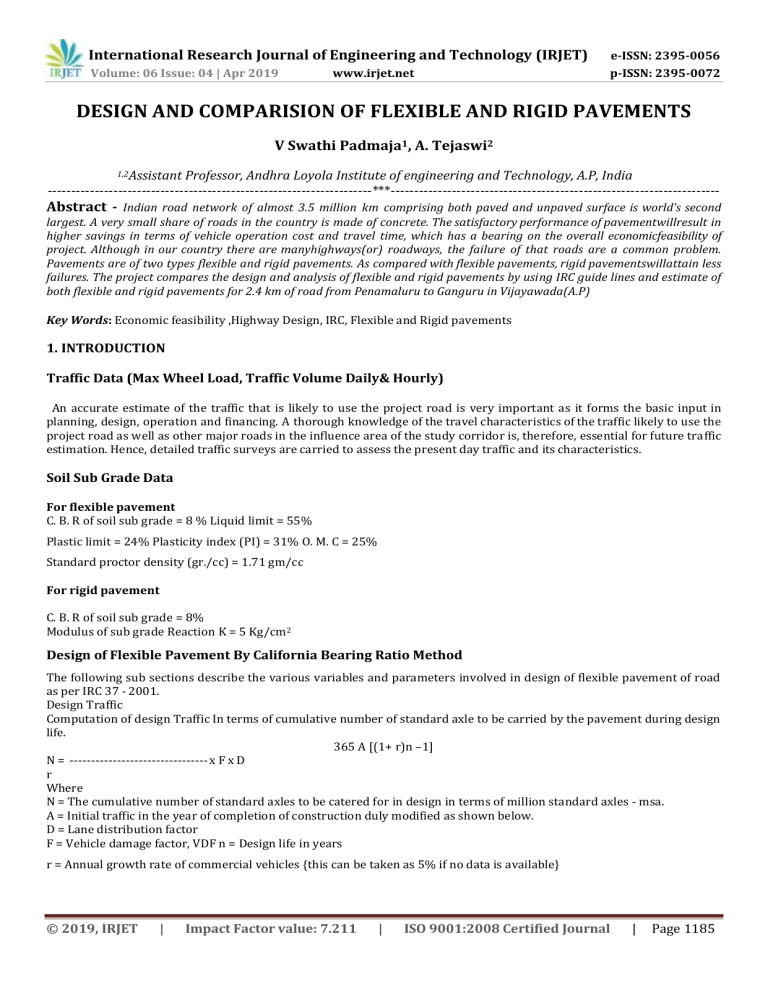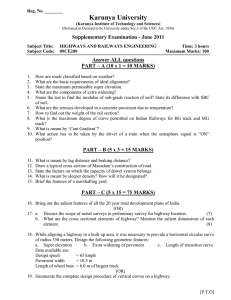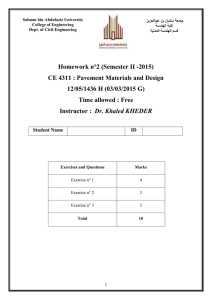Flexible vs. Rigid Pavement Design: A Comparative Analysis
advertisement

International Research Journal of Engineering and Technology (IRJET)
e-ISSN: 2395-0056
Volume: 06 Issue: 04 | Apr 2019
p-ISSN: 2395-0072
www.irjet.net
DESIGN AND COMPARISION OF FLEXIBLE AND RIGID PAVEMENTS
V Swathi Padmaja1, A. Tejaswi2
1,2Assistant
Professor, Andhra Loyola Institute of engineering and Technology, A.P, India
---------------------------------------------------------------------***----------------------------------------------------------------------
Abstract - Indian road network of almost 3.5 million km comprising both paved and unpaved surface is world’s second
largest. A very small share of roads in the country is made of concrete. The satisfactory performance of pavementwillresult in
higher savings in terms of vehicle operation cost and travel time, which has a bearing on the overall economicfeasibility of
project. Although in our country there are manyhighways(or) roadways, the failure of that roads are a common problem.
Pavements are of two types flexible and rigid pavements. As compared with flexible pavements, rigid pavementswillattain less
failures. The project compares the design and analysis of flexible and rigid pavements by using IRC guide lines and estimate of
both flexible and rigid pavements for 2.4 km of road from Penamaluru to Ganguru in Vijayawada(A.P)
Key Words: Economic feasibility ,Highway Design, IRC, Flexible and Rigid pavements
1. INTRODUCTION
Traffic Data (Max Wheel Load, Traffic Volume Daily& Hourly)
An accurate estimate of the traffic that is likely to use the project road is very important as it forms the basic input in
planning, design, operation and financing. A thorough knowledge of the travel characteristics of the traffic likely to use the
project road as well as other major roads in the influence area of the study corridor is, therefore, essential for future traffic
estimation. Hence, detailed traffic surveys are carried to assess the present day traffic and its characteristics.
Soil Sub Grade Data
For flexible pavement
C. B. R of soil sub grade = 8 % Liquid limit = 55%
Plastic limit = 24% Plasticity index (PI) = 31% O. M. C = 25%
Standard proctor density (gr./cc) = 1.71 gm/cc
For rigid pavement
C. B. R of soil sub grade = 8%
Modulus of sub grade Reaction K = 5 Kg/cm2
Design of Flexible Pavement By California Bearing Ratio Method
The following sub sections describe the various variables and parameters involved in design of flexible pavement of road
as per IRC 37 - 2001.
Design Traffic
Computation of design Traffic In terms of cumulative number of standard axle to be carried by the pavement during design
life.
365 A [(1+ r)n –1]
N = -------------------------------- x F x D
r
Where
N = The cumulative number of standard axles to be catered for in design in terms of million standard axles - msa.
A = Initial traffic in the year of completion of construction duly modified as shown below.
D = Lane distribution factor
F = Vehicle damage factor, VDF n = Design life in years
r = Annual growth rate of commercial vehicles {this can be taken as 5% if no data is available}
© 2019, IRJET
|
Impact Factor value: 7.211
|
ISO 9001:2008 Certified Journal
|
Page 1185
International Research Journal of Engineering and Technology (IRJET)
e-ISSN: 2395-0056
Volume: 06 Issue: 04 | Apr 2019
p-ISSN: 2395-0072
www.irjet.net
2. Design of Flexible Pavement
To Design the pavement for the construction of new road with the following data :
Data
I.
II.
III.
IV.
Two-lane single carriage way
Initial traffic in the year of Design of opening =3414 vehicles per day
Type of soil = Black cotton soil[CH]
Type of terrain = Plain terrain
Design calculations
Cumulative number of vehicles per day over the road obtained from the traffic volume study =3414
Step 1 Consider, the laying of the pavement will be completed in six months
Then, the initial traffic after the year of opening
= 3414(1+0.05)0.5 = 3498
Step 2
i.
Vehicle damage factor F = 4.5 (taken from IRC: 37- 2001, clause 3.3.4.4) as the location of site is plain terrain.
Table -1
Initial traffic volume in terms of no. of
commercial vehicles per day
0-150
Terrain
Rolling/pla in Hilly
1.5
0.5
150-1500
3.5
1.5
>1500
4.5
2.5
ii.
Lane distribution factor for a 2-lane carriage way D = 0.75 (from IRC: 37-2001 clause 3.3.5.1)
iii.
Assume the design life of the pavement = 15 years.
Step 3 Computation of design traffic:
Cumulative number of standard axles to be catered in terms of design msa
N=
Number of standard axles catered for 5 years,
N=
= 23.8 = 23msa
Number of standard axles catered for 10 years N=
=54.1=54msa
Number of standard axles catered for 15 years Number of standard axles catered for 15 years
N=
= 92 = 92 msa
No. Of cumulative standard axles catered during different design periods
Table -2
Year
2017
4
Design Traffic in terms of msa
© 2019, IRJET
|
Impact Factor value: 7.211
|
2023
23
2028
54
2033
92
ISO 9001:2008 Certified Journal
|
Page 1186
International Research Journal of Engineering and Technology (IRJET)
e-ISSN: 2395-0056
Volume: 06 Issue: 04 | Apr 2019
p-ISSN: 2395-0072
www.irjet.net
Step 4 :The California bearing ratio (C.B.R) of the sub-grade black cotton soil = 8% .
Total pavement thickness for CBR 8% and traffic 92msa (from Chart -1 of IRC:37-2001) = 640mm
Chart -1:
Chart -2
Step 5: Pavement Design Catalogue
Chart-2 Recommended design for traffic range 10-150 msa
Table -3
CBR 8%
Cumulative traffic msa
Total pavement
thickness(mm)
10
20
30
50
100
150
550
575
590
610
640
660
Pavement Composition
Bituminous surfacing Granular Base And Sub
BC(mm) DBM(mm)
Base
40
40
40
40
50
50
60
85
100
120
140
160
Base = 250
Sub base = 200
Pavement composition interpolated from Plate 2, CBR 8%
(a) Bituminous surfacing = 50mm BC +140mmDBC
(b) Road base= 250mm
(c) Sub-base = 200mm granular material of CBR not less than 30 %.
© 2019, IRJET
|
Impact Factor value: 7.211
|
ISO 9001:2008 Certified Journal
|
Page 1187
International Research Journal of Engineering and Technology (IRJET)
e-ISSN: 2395-0056
Volume: 06 Issue: 04 | Apr 2019
p-ISSN: 2395-0072
www.irjet.net
3. Design of rigid pavement
Design a cement concrete pavement for a two-lane single carriage way. The total two-way traffic is 3498 commercial
vehicles per day at the end of construction period.
The design parameters are:
Grade of the cement concrete =M40 CBR value of sub-grade= 8%
Modulus of sub-grade reaction (k) =5 kg/cm² Elastic modulus of concrete= 3 x 10 5 kg/cm2 Poison’s ratio = 0.15
Coefficient of thermal coefficient of concrete
=10 x 10-6/
Rate of traffic increase= 0.05(AS PER IRC 37:2012)
Design
Present traffic = 3414 CVPD, Design life = 30 years
Annual growth of traffic= 0.05
Cumulative repetition in 20 yrs
= 3414 x 365
= 82790112 commercial vehicles
Design traffic = 25 percent of total repetitions of commercial vehicles= 0.25 x 82790112 = 20697528
Assuming the design axle load of 8160 kg Grade of concrete = M 40
i.e.
characteristic compressive strength of concrete=40 MPa Flexural strength of concrete = 0.7
= 4.427 N/mm2 = 4.5 N/mm2
For 90 days there is 20 per cent increase in the strength of 28 days=
= 0.7 x
=5.312 N/mm2
Trail thickness = 270 mm
Warping stresses:
Length of the slab
LX = 4.5 m Width of contraction joint LY = 3.5 m
Radius of relative stiffness
E = 3 X 105 kg/cm2 ,K = 5 kg/cm² , h = 27 cm,
, t=20.58
=100cm
LX/l =
=4
CX = 0.63; LY/l =
= 3.5
Cy = 0.38;
Warping stress at edge
Ste = CEet/2 =0.63x3x105x10x10-6x20.58/2=19.44kg/cm2 Residual strength in concrete slab at edge region
= 45-19.44=25.55kg/cm2
Stress at corner at region = 3p/h2(1-a√2/l)
= 3x8160/272(1-21.5√2/100) =23.3kg/cm2
Factor of safety
= 25.5/23.3=1.09>1 (hence safe) Hence trail thickness of 27 cm is safe
Equivalent radius of resisting section,
Radius of contact area a =
© 2019, IRJET
|
= 21.5 cm 1.724 x 20 = 34.48 > a
Impact Factor value: 7.211
|
ISO 9001:2008 Certified Journal
|
Page 1188
International Research Journal of Engineering and Technology (IRJET)
e-ISSN: 2395-0056
Volume: 06 Issue: 04 | Apr 2019
p-ISSN: 2395-0072
www.irjet.net
= 20 cm. Warping stress at interior portion
=21.69 kg/cm2
Warping stress at corner portion
= 11.22
kg/cm2
Warping stress at the edge portion
Winter mid-day
σcritical = σte+σe+σf=19.44+23.6+0.81=43.04kg/cm² Mid nights
σ critical = σc+ σtc=25.46+11.22=36.68kg/cm² Total edge stresses = 23.6+19.44=43<45kg/cm²
Total corner stresses = 25.46+11.22=36.68<45kg/cm²
Hence trail thickness is safe. so provide cc slab thickness as 270 mm
Design of dowel bars
Assume the diameter of the dowel rod = 3.2 cm Percentage of load transfer =40
Spacing between the dowel bars = 0 to 1. 8l = 0 to 158 cm
But, assume spacing between the dowel bars as 300 cm and length of the dowel bar as 50 cm (as per IRC
recommendation).
Permissible bearing stress
= 292 kg/cm2
Frictional stresses
= 0.81 kg/cm2
= 19.44 kg/cm2
Number of dowel bars required for the load transfer = 1+
= 1+
= 5 bars
Assuming that the load transferred by first dowel is Pt and assuming that the load on the dowel bar at a distance of l
Stress due to load at edge potion
from the first dowel bar to be zero, the total load transferred by the dowel bar system
=
Load carried by the outer dowel bars
= 2Pt
Corner stress
© 2019, IRJET
|
Impact Factor value: 7.211
|
ISO 9001:2008 Certified Journal
|
Page 1189
International Research Journal of Engineering and Technology (IRJET)
e-ISSN: 2395-0056
Volume: 06 Issue: 04 | Apr 2019
p-ISSN: 2395-0072
www.irjet.net
=23.6 kg/cm2
Pt =
=
= 1632 kg
Check for bearing stress:
= 25.46 kg/cm2 Combination of stresses Summer mid-day:
σcritical= σe+σte-σf=23.6+19.44-0.81=42kg/cm²
Moment of inertia of the bar
=
=
=
= 5.147 cm2 Relative stiffness of the bar
= 0.4
Bearing stress in the dowel bar
4. ESTIMATION OF THE EARTH WORK
The cost of Embankment is calculated as below
= 47.59< 292 kg/cm2
Hence the dowel bar spacing and diameter assumed is safe.
Table -4: Abstract of estimate of earthwork
Particulars
Embankment
Quantity
180236 m3
Rate per % meter
275.00
Cost
4,95,649
Design of tie bars
Allowable tensile stress in plain bars, kg/cm2 = 1250 (As per IRC: 21-2000)
Allowable bond stress in plain bars, kg/cm2
= 17.5 (As per IRC: 21-2000)
Spacing of the tie bar:
Area of steel bar per meter width of joint to resist the frictional force from bottom of slab
= 2.72 cm2/m
Assuming a tie bar of diameter of 12 mm, the cross- sectional area
Perimeter of the tie bar,
Spacing of tie bars
© 2019, IRJET
P=
=
|
=
= 1.13 cm2
= 3.76 cm
= 41.5 cm<45 cm Provide at a spacing of 41.5 cm c/c
Impact Factor value: 7.211
|
ISO 9001:2008 Certified Journal
|
Page 1190
International Research Journal of Engineering and Technology (IRJET)
e-ISSN: 2395-0056
Volume: 06 Issue: 04 | Apr 2019
p-ISSN: 2395-0072
www.irjet.net
Length of tie bar:
Length of the tie bar
=
= 42.9 cm
Increase the length of the bars by 10 cm for loss due to painting and 5 cm for placement
L = 43+10+5= 58 cm.
Adding 5% contingencies and work establishment
= 495649 x (5/100) = 24,782 /Total cost of embankment = 5,20,431/Estimation of flexible pavement:
The estimation of the flexible pavement is carried out using the laying procedure and the Standard Schedule of Rates (SOR:
2015-16).
The Estimated cost of Flexible Pavement was obtained as=8911450/Add 5 percent contingencies for equipment and tools and work establishment charges = 8911450 X 0.05
= Rs 4,45,572/Therefore, total amount required for laying of flexible pavement along with maintenance cost considering the laying of
surface course for every 5 years and excluding the labour charges is
= 8911450+445572
= Rs 93,57,022/-
Estimation of rigid pavement
The estimation of the Rigid pavement is carried out using the laying procedure and the Standard Schedule of
Rates(SOR:2015-16).
The Estimated cost of Rigid Pavement was obtained as=2,13,74,640 /Add 5 percent contingencies for work establishment and other charges = 2,13,74,640 x 0.05= Rs 10,68,732 /Total amount required for the laying of rigid pavement
= 2,13,74,640 + 10,68,732 = Rs 2,24,43,372/5. RESULTS
Table: 5: Results Table
The total thickness of the flexible pavement crust
640 mm
The thickness of the slab of rigid pavement
270 mm
Diameter of dowel bar
length of dowel bar
The number of dowel bars required for the rigid
32 mm
500 mm
5
pavement
Diameter of tie bar
Length of tie bar
The number of tie bars required for the rigid
12 mm
580 mm
4
pavement
The estimated cost for the laying of flexible
Rs. 93,57,022 /-
pavement along with the rehabilitation works( for
maintenance) carried out for every 5 years
The estimated cost of rigid pavement
© 2019, IRJET
|
Impact Factor value: 7.211
|
Rs. 2,24,43,372/-
ISO 9001:2008 Certified Journal
|
Page 1191
International Research Journal of Engineering and Technology (IRJET)
e-ISSN: 2395-0056
Volume: 06 Issue: 04 | Apr 2019
p-ISSN: 2395-0072
www.irjet.net
6. CONCLUSIONS
The following conclusions are drawn from this study:
1. With increase in the California bearing ratio of the soil the thickness of the pavement decreases.
2.
It is observed that flexible pavements are more economical .The life of flexible pavement is nearly about 15 years
whose initial cost is low needs a periodic maintenance after a certain period and maintenance costs very high.
3. The life of rigid pavement is much more than the flexible pavement of about 30 years approx 2 times life of flexible
pavement whose initial cost is much more than the flexible pavement but maintenance cost is very less.
4. From the results we can conclude that the cost of rigid pavement is double that of flexible pavement. so flexible
pavements are more economical when compared totherigid pavement in terms of economy
REFERENCES
1) S.k. Khanna and C.E.G. Justo (2011), “Highway engineering”, Nem Chand & Bros publications, 2011 .
2) L.R. Kadiyali, N.B. Lal, “Principles and Practices of Highway Engineering”, Khanna publishers, 2005.
3) IRC: 37-2012, “IRC Guidelines for the Design of Flexible Pavements” (second revision), 2001.
4) IRC: 58-2002, “ IRC Guidelines for the Design of Plain Jointed Rigid Pavements for Highways” (second revision), 2002.
5) IRC: 15-2002, “Standard Specifications and Code for practice for Construction of Concrete Roads” (third revision),
2002.
6) B.N. Dutta, “Estimating and Costing in Civil engineering”, UBS publishers' distributors (p) ltd. -New Delhi,2005.
7) Schedule Of Rates as per A.P Revised Standard Data for the year 2015-2016.
8) D. Kornack and P. Rakic, “Cell Proliferation without Neurogenesis in Adult Primate Neocortex,” Science, vol. 294, Dec.
2001,
pp.
2127-2130, doi:10.1126/science.1065467.
9) M. Young, The Technical Writer’s Handbook. Mill Valley, CA: University Science, 1989.
10) R. Nicole, “Title of paper with only first word capitalized,” J. Name Stand. Abbrev., in press.
11) K. Elissa, “Title of paper if known,” unpublished.
© 2019, IRJET
|
Impact Factor value: 7.211
|
ISO 9001:2008 Certified Journal
|
Page 1192


